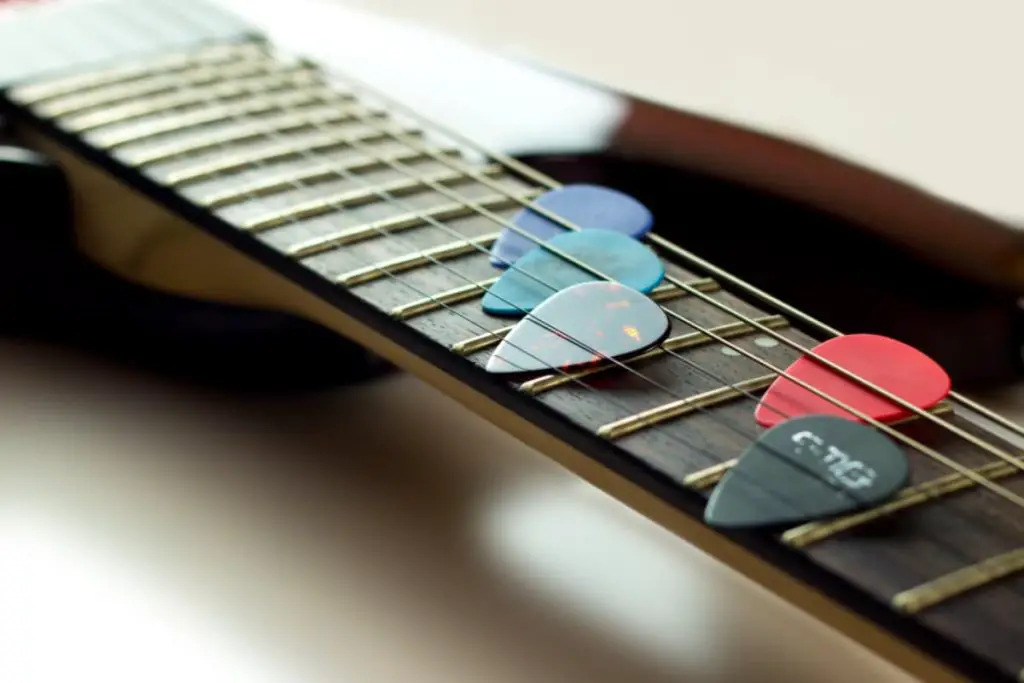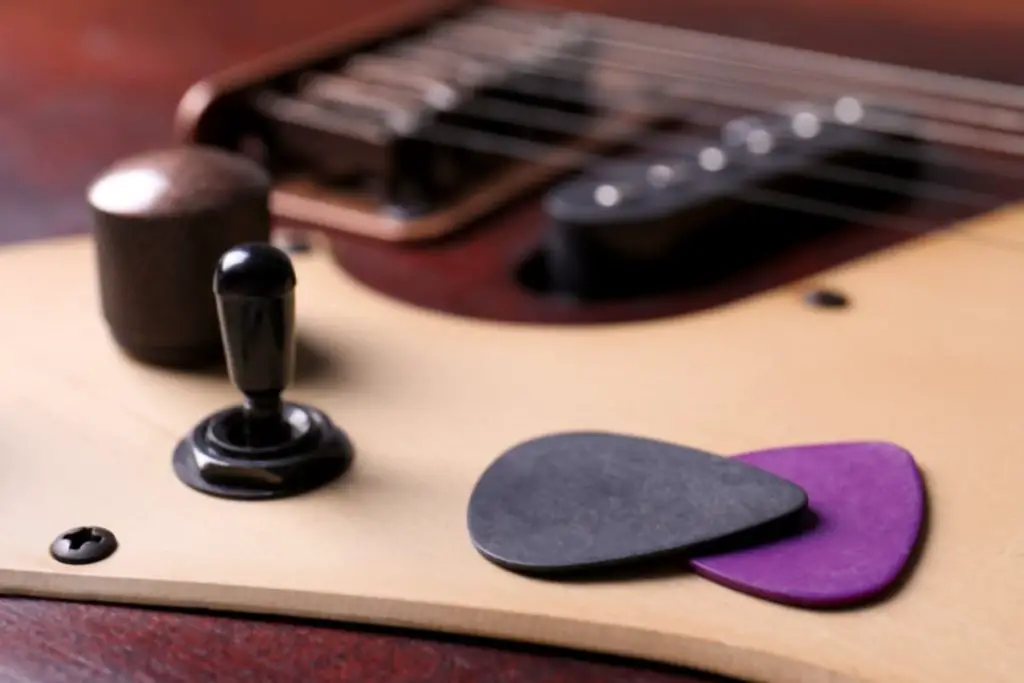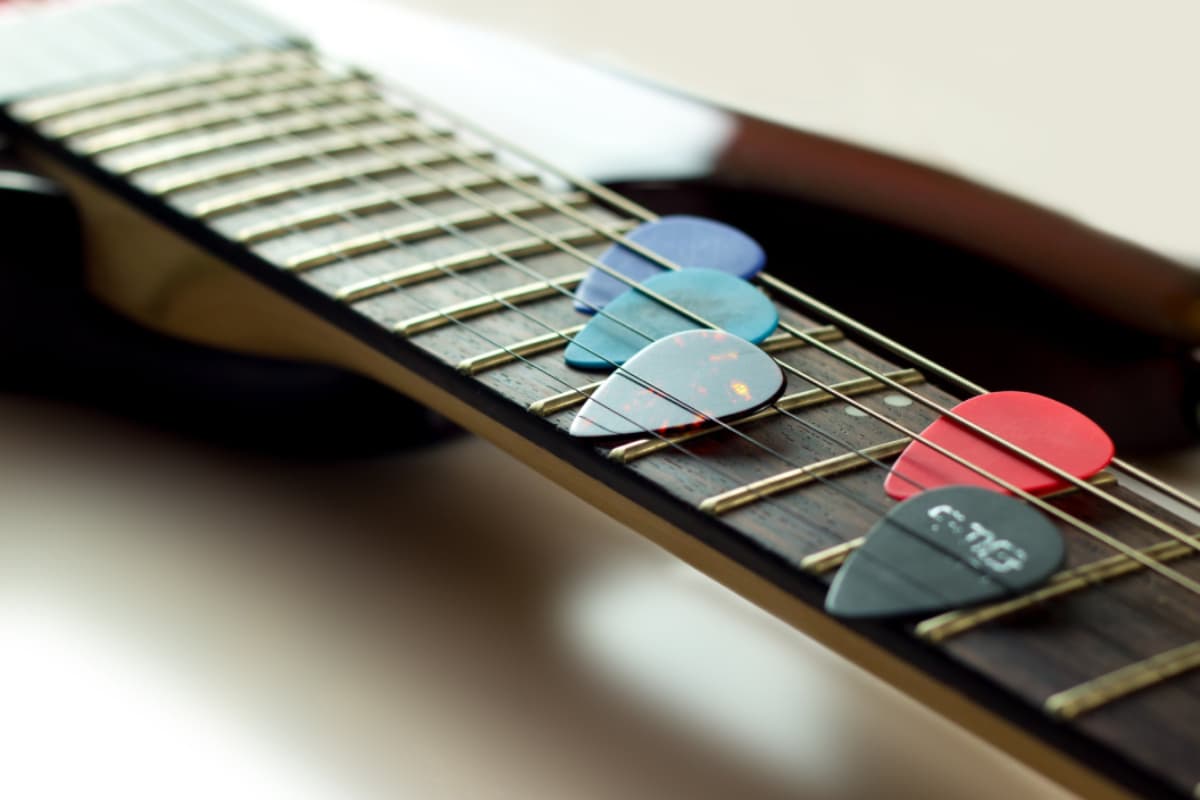Guitar picks play a crucial role in enhancing playability and minimizing the development of calluses on your hand’s skin. But like any other part of your rig, guitar picks can’t provide their unique benefits if worn out; that’s why knowing the signs of wear is critical. The problem is that it can be hard to tell when your pick is worn out because picks wear at varying rates due to factors such as the pick’s material, thickness, and your playing style.
Here are 15 signs that your guitar pick is worn out:
- Discomfort striking strings.
- A worn down and rounded pick tip.
- A fading or invisible logo.
- Cracks.
- Stress marks.
- A change in your Guitar’s sound quality.
- Grooves forming on the pick.
- Frayed edges.
- Difficulty strumming individual notes.
- Strings getting stuck in pick grooves.
- A loose guitar pick.
- Poor pick slides.
- Diminished pick texture.
- Frequently popping guitar strings.
- A change in the guitar’s tone.
This article expounds on these signs to help you tell when your guitar pick has exhausted its lifespan. Keep reading for details.
👇😀👇NOTE👇😀👇
If you want to find out what my recommended guitar gear is, then here is what I recommend on Amazon:
- Fender Cutaway Acoustic-Electric Guitar Bundle (MY FAVORITE GUITAR)
- Snark SN-8 Super Tight All Instrument Tuner (Easiest Tuner I’ve Used😏)
- 6 String Acoustic Guitar Capo (Best CAPO for quick changes)
- Dunlop Max Grip 1.0mm Nylon Picks (Thick Guitar Pick So You Don’t Lose Grip!)
- Universal Guitar Stand (Cheap & Minimalist Guitar Stand I Recommend)
- Levy’s 2″ Wide Quick Adjust Guitar Strap (Best Guitar Strap For Any Level)

1. Discomfort Striking Strings
The first sign that your guitar pick is worn out is discomfort when striking strings on your guitar. Ideally, guitar picks should help you play your guitar better than you would without them. One such way is by preventing calluses and blisters from forming on your palms and fingers.
After prolonged use, guitar strings develop chips and bends that cause discomfort. Anyone who has played guitar understands how much comfort contributes to your playing ability. This is especially true for musicians and performers who play long live shows. Such situations require comfortable music instruments, including the guitar and guitar picks.
So if you notice your guitar pick getting less comfortable with time, consider getting a new one because the one you’re using is worn out.
If you’re in the market for comfortable guitar picks, I recommend getting D’Addario Accessories Pearl Celluloid Picks (available on Amazon.com). This guitar picks pack includes 8 light (.50mm White pearl), 9 Medium (.70mm red Pearl), and 8 heavy (1.0mm black pearl) picks designed in the standard shape for ultimate comfort regardless of your playing style.
2. A Worn Down and Rounded Tip
The next sign that your guitar pick is worn out and needs replacing is a worn down and rounded tip. Usually, guitar picks have straight, thin, sharp tips for more straightforward strumming of individual strings, including the tiniest ones.
As the guitar pick’s tip strums across the guitar over time, it produces friction. That chips away at the tip, resulting in a worn-down and rounded tip.
Guitar picks with rounded tips usually produce a mellow tone compared to those with straight tips, which produce much brighter tones. So if your guitar tone suddenly changes and the pick tip looks rounded, chances are the pick is worn out.
That said, you should note that some guitar picks are intentionally designed with rounded tips to produce specific tones and feelings. So before you conclude that your pick is worn out based on the shape of its tip, confirm that it didn’t come with this design.

3. A Fading or Invisible Logo
The other sign to watch out for is a fading or invisible logo on the guitar pick. Fading logos indicate how much usage the guitar pick has undergone.
As you use your guitar pick, the friction produced eats away at the material, causing it to thin and lose effectiveness. The fading or invisible logo indicates that the guitar pick has lost its thickness and flexibility due to prolonged use.
An invisible logo is an excellent measure to establish that the guitar pick has been overused because different guitar picks have varying lifespans. Usually, the lifespan of a guitar pick depends on multiple factors, including the material it’s made from, its thickness, your strumming patterns, and the type of guitar strings.
4. Cracks
Cracks are another sign that you should replace your guitar pick. Unfortunately, most materials used to make guitar picks crack over time due to abrasion. Other factors contributing to cracks on guitar picks include the thinness of the guitar pick, your strumming technique, and the thickness of the guitar strings.
Thin guitar picks are likely to crack if they are used on thick guitar strings 一 like those on a bass guitar. They are also likely to crack if you use a hard, aggressive strumming pattern.
The first alternative is to use a guitar pick made from durable material like metallic picks. However, some people don’t like the sound produced when strumming with metallic picks. They prefer guitar picks made from standard material because they produce softer, brighter tones and are less likely to break thin strings.
If you are interested in a durable guitar pick made from standard material, I recommend getting the Dunlop 449P.73 Max-Grip (available on Amazon.com). It is made from durable nylon that doesn’t crack easily and is available in various mm gauges.

5. Stress Marks
The material used to make most guitar picks is more likely to develop cracks and stress marks than break. However, subjecting a guitar pick with stress marks to constant pressure from repeated aggressive strumming will break it. That’s why you must be mindful of your guitar pick’s condition before using it to avoid breaking it as you play.
Stress marks usually develop on guitar picks when they bend along the same line multiple times from repeated action. As the guitar pick bends each time, the stress marks become more profound, affecting its effectiveness and increasing the likelihood of breaking.
One way to reduce stress marks is to hold your guitar pick correctly. Unfortunately, it’s human nature to hold the guitar pick whichever way it feels comfortable. The problem with this is that your holding technique may increase the chances of your guitar pick folding.
Fortunately, new guitar picks usually come in sets, giving you enough picks to use interchangeably for a lengthy period.
6. A Change in Your Guitar’s Sound Quality
Most of the signs discussed above focus on the physical defects showing that a guitar pick is worn out. These are fairly easy to determine because you can see the damage.
But in some cases, the guitar pick may be faulty in some cases without easily discernible physical defects. In such instances, you can determine your guitar pick’s condition by observing your guitar’s sound quality.
New guitar picks usually have sharp, thin tips that strum against the strings to produce a loud and bright sound. On the other hand, worn-out guitar picks with rounded tips usually produce mellower and duller sounds.
So if you notice that the sound quality of your guitar deteriorates when you use a certain pick, it might be time to shop for a replacement. To be sure whether the pick in question is faulty, switch to a newer similar pick and observe your guitar’s sound quality. If the new pick improves sound quality, the older one is probably worn out.

7. Grooves Forming on the Pick
Grooves are long and narrow cuts that often develop on hard surfaces. Guitar picks are no different because they can develop grooves on their edges and surfaces for various reasons.
Grooves are problematic because they distort the guitar pick’s shape and size, which are essential to its effectiveness. A guitar pick’s design, size, and shape are deliberately optimized to produce a certain quality of sound from your guitar. Having grooves in our pick compromises this optimization, ultimately affecting your guitar’s audio.
Grooves also prevent you from holding the pick well. Not only does that affect your playing ability, but it also causes inconveniences such as slippery picks.
Worse still, using a guitar pick with grooves may predispose you to other issues:
- The picks may wear out your guitar strings, necessitating replacement.
- You may find yourself having to tune your guitar frequently.
So anytime you notice your guitar pick has cuts on its surface and edges, that’s your cue to get a new one. It will make guitar playing smooth and mitigate the cost of replacing worn-out guitar strings.
8. Frayed Edges
The next sign to look out for is frayed edges on your guitar pick. Guitar picks with frayed edges are different from those with grooves because you can still play with them fairly well. The difference is in the quality of sound produced.
Frayed edges are a natural process caused by prolonged use and repeated contact between the rough strings and the smooth edge of a new guitar pick. As such, they aren’t necessarily a sign of worn-out guitar picks for some people (e.g., jazz music players and electric guitar players).
However, frayed edges do affect the sound quality and playability for most players with acoustic guitars that require smoother tips for clearer and sharper sounds.
9. Difficulty Strumming Individual Notes
The next sign that your guitar pick is worn out is difficulty playing individual notes. Most picks are suitable for strumming any type of guitar. However, picking single notes requires different picks depending on the type of guitar you are using.
For example, using a very thin guitar pick to play individual strings of a bass guitar is not ideal. On the contrary, it increases the chances of the pick breaking. Bass guitar strings are thicker and tighter, so they need more pressure from medium or large guitar picks.
On the other hand, using thick or large guitar picks to play individual notes on the tiny strings of an acoustic guitar increases the chances of breaking the guitar strings. Such guitars need a thin guitar pick to optimize sound quality and minimize the risk of breaking the strings (Question: do guitar picks wear out?).
So whenever you start experiencing difficulty picking individual notes, consider replacing your guitar pick because its tip is likely worn out and rounded.

10. Strings Getting Stuck in Pick Grooves
The next sign that your guitar pick is worn out is strings constantly getting stuck in pick grooves. Pick grooves provide openings for strings to latch onto as you play the guitar. This makes it difficult to play well because it breaks the continuity required in music as the strings repeatedly get stuck.
So if your guitar strings keep getting stuck to your pick, that should should be your cue to check it for grooves. You must always ensure that your picks have fairly smooth edges to facilitate uninterrupted playing instead of rough edges with grooves that strings can stick to.
If you prefer guitar picks with rougher edges, ensure the rough edges are not deep enough to disrupt your playing.
11. A Loose Guitar Pick
Guitar players often debate whether guitar picks should be flexible or stiff. Some players prefer flexible picks because they offer cleaner and brighter sounds, while others prefer playing with the control gained from stiff guitar picks.
If you prefer a flexible guitar pick, ensure it is snappy with some resistance. If the guitar pick is too loose, you cannot strum the guitar strings with sufficient force to produce a loud enough sound. Moreover, loose guitar picks are ineffective when picking individual notes because they cannot generate enough force to move the strings.
A guitar pick can become loose following repeated use. Prolonged use creates stress marks that run deep enough to weaken the guitar pick’s material. That’s why you should get a new guitar pick or ensure you have a backup whenever you notice stress marks on your guitar pick.
12. Poor Pick Slides
Poor pick slides also indicate that a guitar pick has become worn and should be replaced. A pick slide is a guitar-playing technique in which the player presses the edge of a pick on the strings and slides it across to produce vibrating notes. This technique is common among rock, punk, and metal music genre guitar players.
You require a pick with smooth edges to facilitate sliding across the strings to produce a clean sound. The guitar pick can also have a slightly rough edge, provided it’s not too rough to affect the pick slides.
Consider changing your guitar pick whenever you start experiencing problems with your pick slides because that’s a sign the guitar pick has rough, groovy, or frayed edges.
13. Diminished Pick Texture
You should also test your guitar pick for diminished texture when checking if it’s worn out. Grip is essential for any guitar pick because it enables you to strum and pick your strings with more control. This minimizes issues such as inaccuracy when playing individual notes and prevents your pick from constantly falling off your fingers and disrupting your guitar playing.
Guitar picks usually lose their grip over time as you use them and the material wears and tears. This explains why guitar players often have multiple guitar picks (Relevant article: Pros and cons of acoustic electric guitar). When one presents grip issues, the guitar player switches to a new pick with a better grip for comfort and to avoid disruptions.
If you are interested in guitar picks with good grip, I recommend the Dunlop 449P.73 Max-Grip® Nylon Standard (available on Amazon.com). These are made with cutting-edge max grip technology and have a nonslip texture across their surfaces to ensure that you do not drop your picks as you play.
Alternatively, purchase the 20-Pack Grips for Guitar Picks (available on Amazon.com). They are made from a grippy rubber material that makes it comfortable to hold guitar picks without losing them. They also combat sweat and allow you to maintain proper grip even if your hands sweat while you play.
14. Frequently Popping Guitar Strings
Quality guitar picks are essential because they can save you money in addition to helping you play comfortably. This is because quality guitar picks with smooth tips and edges prevent guitar strings from constantly snapping (Related: what to do if your guitar string breaks).
Guitar picks with rough edges and grooves cause guitar strings to break. That’s because as you play, strings get stuck in the spaces and snap as you pull and push in opposite directions during strumming.
Worn-out guitar picks also generate a lot of friction when in contact with guitar strings, hastening the wear and tear process. This results in guitar strings weakening and breaking faster, costing you more money for a replacement.
That’s why you should get a new guitar pick of good quality whenever your pick is worn out to minimize the risks of guitar strings constantly popping. A new pick guarantees you enjoy playing your guitar and helps boost the sound quality.
15. A Change in the Guitar’s Tone
Guitar players usually prefer different picks depending on their music genre and type of guitar. This is because guitars produce a different sound depending on the pick. For example, playing an electric guitar with a plectrum gauge suitable for acoustic guitars results in the instrument producing a slightly different sound. The sound may be sharper or duller depending on the guitar pick.
This same effect usually happens when your guitar pick is worn out. The guitar produces a different sound than before because the worn-out guitar pick is essentially a different pick. Wear gives it rounded and rougher edges, which produce a different sound.
So if you notice a sudden, unexplainable change in your guitar tone, it’s likely a sign that the pick needs replacing.
👇😀👇NOTE👇😀👇
If you want to find out what my recommended guitar gear is, then here is what I recommend on Amazon:
- Fender Cutaway Acoustic-Electric Guitar Bundle (MY FAVORITE GUITAR)
- Snark SN-8 Super Tight All Instrument Tuner (Easiest Tuner I’ve Used😏)
- 6 String Acoustic Guitar Capo (Best CAPO for quick changes)
- Dunlop Max Grip 1.0mm Nylon Picks (Thick Guitar Pick So You Don’t Lose Grip!)
- Universal Guitar Stand (Cheap & Minimalist Guitar Stand I Recommend)
- Levy’s 2″ Wide Quick Adjust Guitar Strap (Best Guitar Strap For Any Level)
Related Posts:

